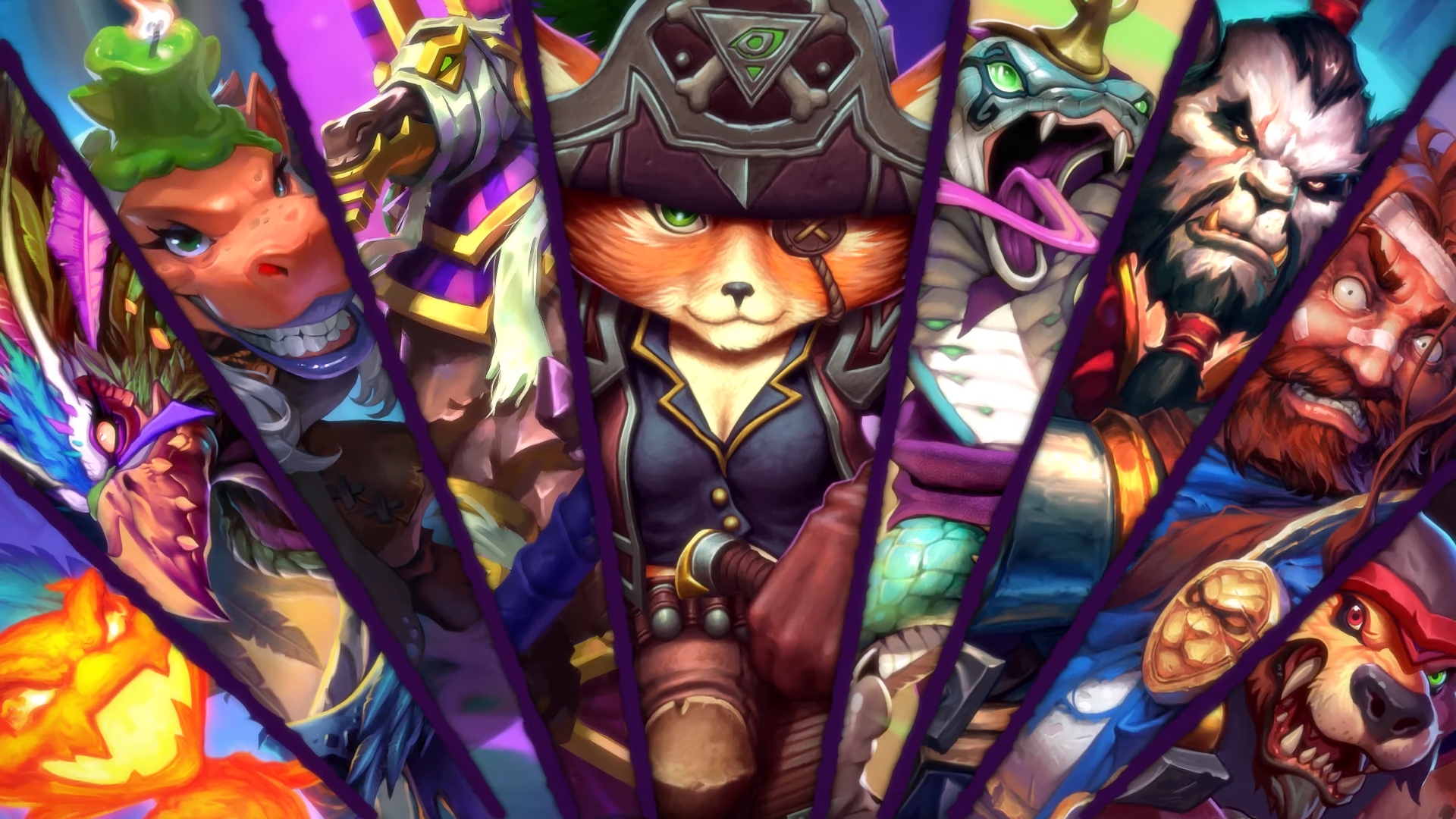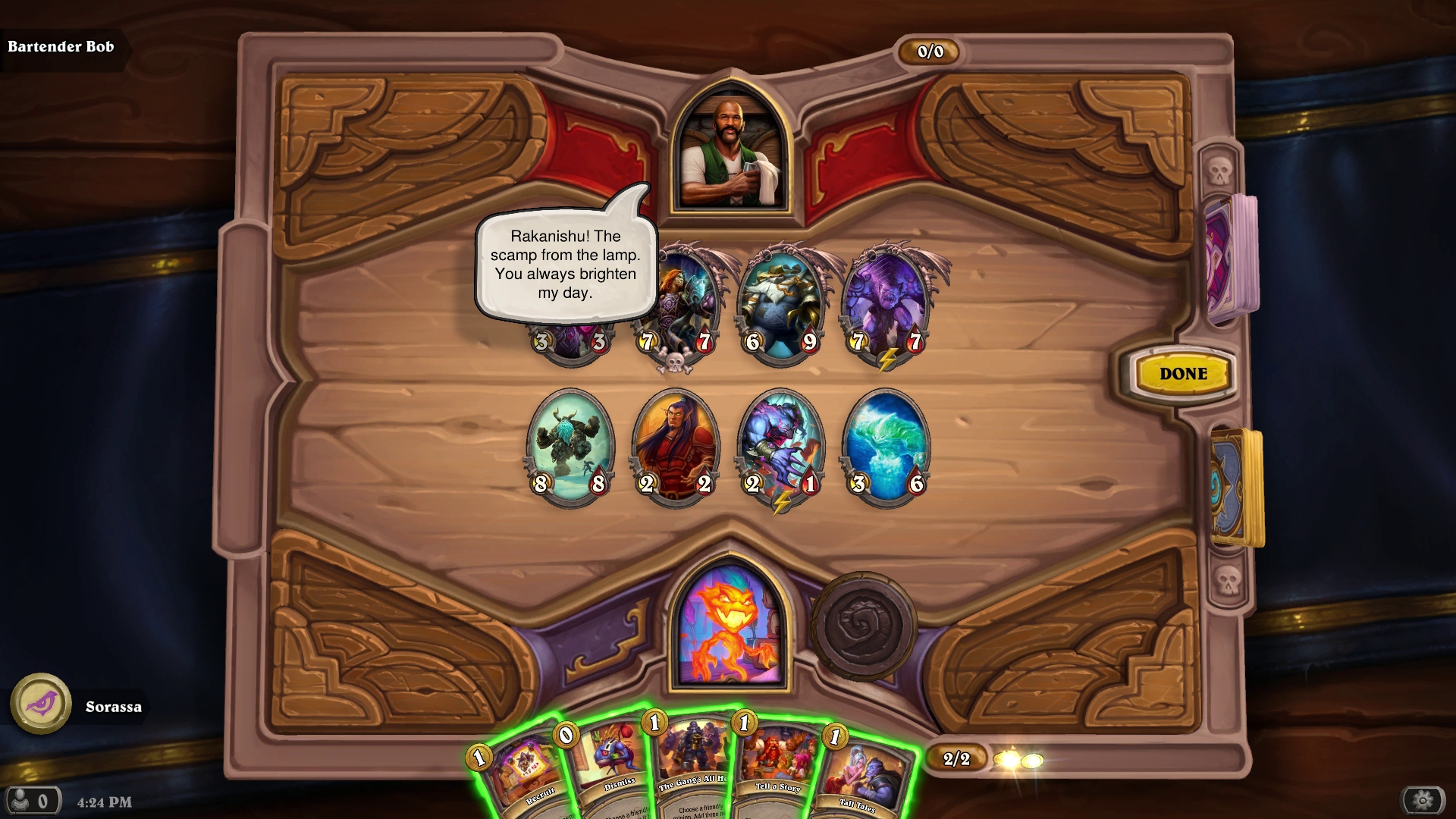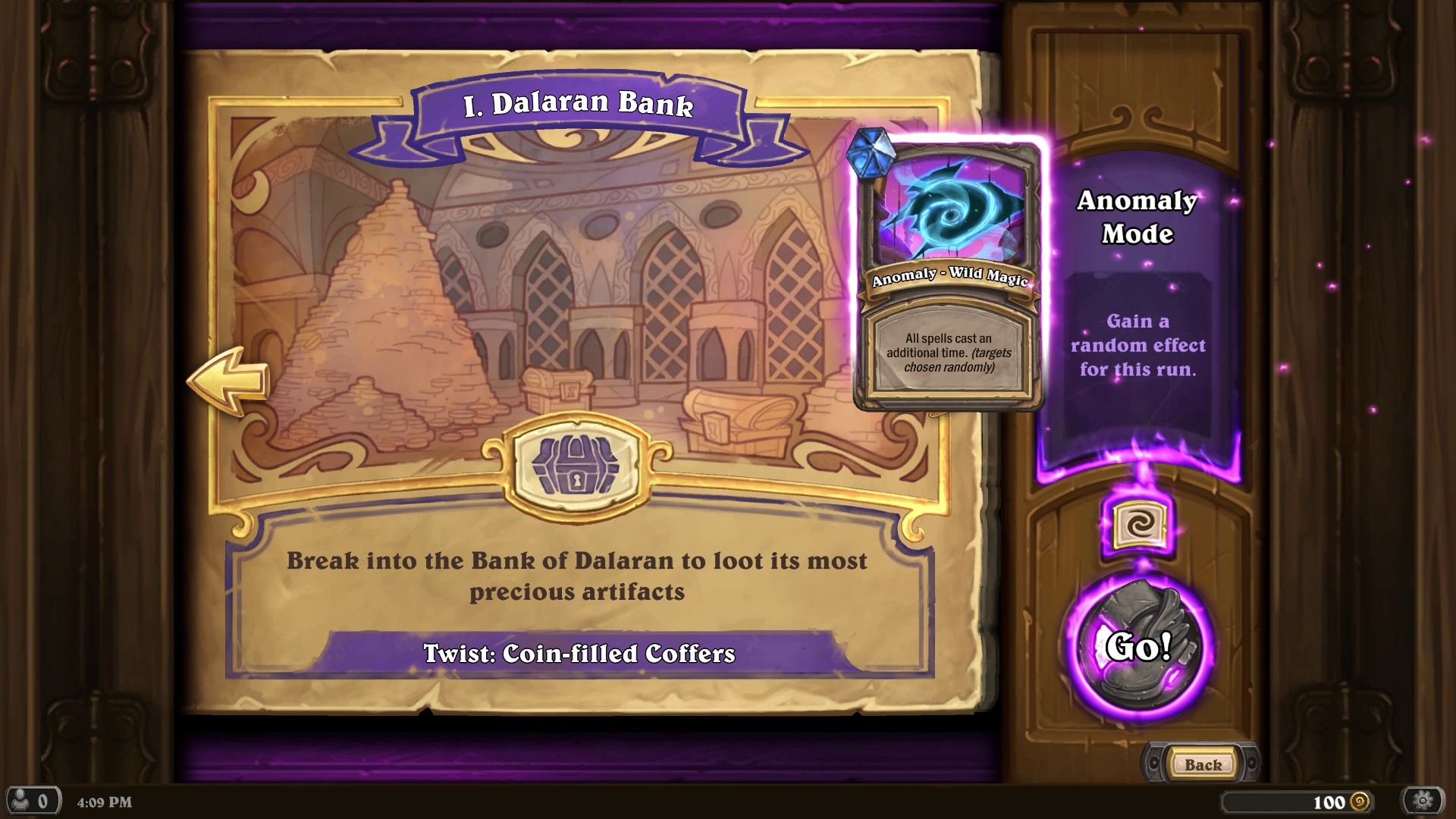Hearthstone has outdone itself with The Dalaran Heist, its best single-player roguelike yet
With a wealth of options and a host of charming heroes, this solo mode has it all
Tracking in Hearthstone isn't just a staple Hunter class card anymore - it's also a huge part of what makes the next Solo Adventures mode so exciting. Blizzard is finally incorporating ways to track all kinds of personal achievements in The Dalaran Heist, the single-player portion of the Rise of Shadows expansion. In keeping with Rise of Shadows' villainous themes, you'll be ransacking the mystical floating city of Dalaran for the League of E.V.I.L., in a roguelike solo mode that offers an incredible amount of choice, fun, and replayability.
Most Hearthstone players will agree that Blizzard struck gold with the roguelike Dungeon Run mode in Kobolds & Catacombs, but the excitement of single-player modes seemed to slip with each subsequent expansion. Monster Hunt in The Witchwood had a great story arc featuring memorable heroes but was over all too soon, and The Boomday Project's Puzzle Lab offered ingenious brain teasers that had no replay value once they'd been solved. Things hit rock bottom with Rumble Run in Rastakhan's Rumble, which was constantly criticized for its repetitive encounters and limitations on class and totem selection that made it nigh impossible to remember what you'd already completed. Blizzard heard those complaints loud and clear, then pulled out all the stops for The Dalaran Heist.
"We are seeing this single-player as our evolution - not necessarily revolution yet, but evolution - of single-player content for Hearthstone," creative director Ben Thompson tells me. "We've learned a lot from the Rumble Run. We learned that players want to find more rewards at the end of their runs, or even intermittently throughout. We learned that they also want more tracking ability as they go through, and learned how progression is really benefiting them through the single-player."
There's a ton of content available in The Dalaran Heist - nine new Henchman heroes, five locations, 27 hero powers, 36 starting decks, and a whopping 75 possible boss encounters - so being able to keep track of what you've done with all those combinations and permutations is a godsend.
Tearing down Dalaran piece by piece

The dastardly Henchman heroes are the stars here, with each class getting its own rakish representative, including a few familiar faces. One such returning character is Rakanishu, the sentient fire elemental who resides in King Togwaggle's lamp and acts as the resident Mage of The Dalaran Heist. You'll have access to Rakanishu straight away, as he's included with the Dalaran Bank, the first of The Dalaran Heist's five chapters. Dalaran Bank is being given free to all players when the mode launches on May 16.
If you want to see this campaign of crime all the way through, you'll have to shell out for additional chapters at 700 gold or $7 apiece, or buy them all in a bundle for a reasonable $20. The thriftier among us may chafe at the idea of having to pay for the single-player modes again, a la the older Solo Adventures packs. But after getting some extensive hands-on time with all five chapters of The Dalaran Heist, I can assure you that this roguelike adventure offers amazing bang for your buck.
While you may be fighting on the baddies' behalf, you don't get to sit at the table with the big dogs like Arch-Villain Rafaam and Dr. Boom. I love that being a Henchman feels like a chance to prove your criminal clout to the League of E.V.I.L. as you wreak havoc in Dalaran against a colorful lineup of cleverly designed boss encounters. As with the previous roguelike modes, the early encounters are mostly pushovers - like the goblin magician illustrated on the Mage card Magic Trick - while the end bosses are unfair fights that require a certain mix of luck, foresight, and strategy. Along the way, you might even have a run-in with the better halves of King Togwaggle and Millhouse Manastorm.
Weekly digests, tales from the communities you love, and more
A ragtag rogues gallery

My favorite part of having nine new heroes to choose from is the wealth of emotes being added to the game, and each Henchman has an instantly lovable design. In addition to Rakanishu the Elemental Mage, there's Kriziki the Arakkoa Priest, Squeamlish the Kobold Druid, Tekahn the Tol'vir Warlock, Captain Eudora the adorable Vulpera Rogue, Vessina the Sethrak Shaman, Mr. Chu the Pandaren Warrior, George the Fallen Paladin (who you might remember from Dungeon Run), and Ol' Barkeye the Gnoll Hunter (all pictured above, from left to right). They all look and sound great, thanks to Blizzard's penchant for polish and attention to detail (which also makes for some great Easter egg card interactions).
Let me just state for the record: Squeamlish is the absolute best. This conniving Kobold is a Druid of the Rat, which sounds like the least flattering animal one could possibly shapeshift into, and I love it. She's also rocking some excellent hero powers. Each Henchman has access to three hero powers: the default class hero power, plus two options that have never been used as hero powers before. You'll have to unlock the additional choices by meeting some simple requirements, like drawing 100 cards or freezing enough minions. Squeamlish's new hero powers are Lifebloom, which restores a minion to full HP, and Touch of Bark, which gives a minion +1/+1. As someone who adores maintaining board control with an army of beefy minions, these hero powers play perfectly to my minion-slaying sensibilities.
Once you've picked your hero power, you'll get your choice of four starting decks to complete your loadout. Three of these have clear, distinct themes with great variety, and synergize well with that Henchman's theme; for instance, Mr. Chu has access to a simple Bomb Warrior deck that goes nicely with his hero power, which shuffles an explosive into the opponent's deck. But, as principal game designer Mike Donais tells me, there's also a wildcard option available. "The fourth [deck] that you unlock in each class will be a semi-random starting deck, so way more replayability," he says. "It's not completely random, because we want you to have a nice mana curve; we want you to have a mix of minions and spells. But it's different every single time you play."
These randomized decks proved to be the most popular with internal playtesters, Donais included, for the sheer variety and their ability to make you think about building your deck in totally unexpected ways. "I played so much in playtesting, what I ended up doing near the end was playing with the random decks a lot," Donais tells me. "I think for the first couple times you playtest, you want to start with the normal decks - but after like a week and you've played those a bunch, you can go to the random decks... it's like 'Oh, what does this mean? How should I play differently? How can I build around these cards?' It's been really fun." Your random deck assembled from Standard and Wild cards probably won't be junk, but sometimes there's fun to be had in rolling the dice and starting with a stinker of a deck, then slowly forging it into a refined champion over the course of a successful run.
Bob the deckbuilder

As with the Dungeon Run and Monster Hunt adventures, you'll pick new cards to add to your deck from three buckets after each victory, occasionally getting your choice of some extremely powerful treasures. But unlike before, not everyone here is out to kill you. You'll also intermittently check in with the delightful Bartender Bob, a helpful follow who acts as a Friendly Encounter where you can tune your deck to perfection. "We learned a lot in the Puzzle Labs on the Boomsday Laboratories, and this was the result - the way that you could see the board as being a little bit different than you usually do in gameplay," Thompson says. "And it ended up being one of the favorite encounters among the team when we've been doing internal playtests."
In a brilliant riff on deckbuilding games like Slay the Spire, chatting with Bartender Bob lets you acquire new cards from whatever's Bob's offering, permanently buff a minion in your deck, dismiss an unwanted card, and much more. I've had Bob's boons single-handedly turn my deck into an absolute powerhouse, like when I pumped up my Recurring Villain into a 4/7 who would never die unless silenced. But I just can't bear to use Dismiss and chuck a card from my deck, due entirely to the card art featuring a dejected-looking murloc preparing to hit the road with his little bindle. Come back, little fella! I'd never turn you away from my villainous gang!
So many ways to play

Each of the five chapters in The Dalaran Heist comes with its own Twist: A persistent effect meant to change the flow of each area. Dalaran Bank has Coffers that you can break open for Coins, The Violet Hold has Imprisoned Minions that are freed after a few turns, Streets of Dalaran has Crowded Streets where three of the seven minion slots on each side are occupied at all times, The Underbelly flips the Attack and Health values of all minions, and Kirin Tor Citadel simply has four additional encounters to turn your run into a marathon. On top of all that, The Dalaran Heist offers Normal and Heroic mode difficulties, with the latter ready to kick your deck to the curb more than a few times. Beating each mode unlocks some sweet card backs, as per usual - with an Aluneth-themed cardback for conquering Heroic that'll look lovely in any Mage player's collection.

There's good reason to invest in buying all five chapters. For starters, you'll need all five if you want to try out all nine heroes. Buying them all also grants you Zayle, Shadow Cloak (not to be confused with Hearthstone streamer Zalae), a five-decks-in-one card that acts like Whizbang the Wonderful by providing access to a randomly selected E.V.I.L. deck recipe. Beating each chapter offers three packs per chapter with the grand finale of a Golden Card Pack once you've finished them all. But the best incentive is Anomaly Mode, which adds a randomly chosen rule alteration like 'All spells cost 2 less' or 'All spells cast twice' to your run. With 18 possible Arcane Anomalies to deal with, that's a lot of extra challenge for you to strive for and Hearthstone to track.
With all those variables and alternative ways to play, The Dalaran Heist will surely be the most addictive, endlessly replayable roguelike mode Hearthstone has seen yet. You'll get the Dalaran Bank right away when it launches on May 16, and the option to buy into the Violet Hold immediately; after that, we'll have to wait (im)patiently for the remaining chapters to open across the following weeks.
I ask Thompson if he thinks the massive amount of content in The Dalaran Heist is setting a precedent for future expansions, especially considering that Rise of Shadows is the first in a three-part trilogy for the Year of the Dragon. "We certainly are making a commitment to single-player as a way to play Hearthstone," he tells me. "I think just taking into consideration players' feedback and thoughts after playing through this, and really spending a lot of time of it, will certainly help inform what we look at for the [next two sets] in the year... we are absolutely committed to a way to play Hearthstone in single-player that feels thought of from the ground up."
If you're just getting started in Blizzard's ever-changing card game, here are the best Hearthstone decks for beginners. Or see what's happening this week in games and entertainment with our latest Release Radar:
Lucas Sullivan is the former US Managing Editor of GamesRadar+. Lucas spent seven years working for GR, starting as an Associate Editor in 2012 before climbing the ranks. He left us in 2019 to pursue a career path on the other side of the fence, joining 2K Games as a Global Content Manager. Lucas doesn't get to write about games like Borderlands and Mafia anymore, but he does get to help make and market them.



